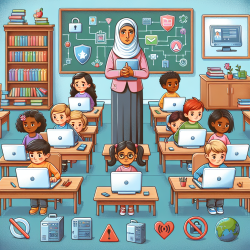Introduction
In our increasingly digital world, ensuring the safety of elementary school children online is paramount. As educators and practitioners, understanding the concerns and actions surrounding digital safety can significantly enhance the protective measures we implement. A recent study titled Teacher and School Concerns and Actions on Elementary School Children Digital Safety provides valuable insights into this topic. This blog will explore the study's findings and offer practical steps for practitioners to improve digital safety for young learners.
Key Findings from the Research
The study conducted interviews with ten elementary school teachers to identify their concerns and actions regarding digital safety. Thematic analysis revealed several key areas of concern:
- Content-Related Concerns: Teachers reported issues with students accessing inappropriate content, such as explicit images and gambling websites. Content filters and supervision are crucial in mitigating these risks.
- Contact-Related Concerns: Inappropriate online interactions, including sharing personal information and friending strangers, were significant worries. Educators emphasized the need for teaching students about the risks of online interactions.
- Conduct-Related Concerns: Cyberbullying and digital footprint awareness were highlighted. Teachers noted that students often struggle to recognize and respond to cyberbullying effectively.
- Contract-Related Concerns: Issues around digital security and privacy, such as sharing passwords, were common. Educators stressed the importance of teaching students about digital privacy and security.
- Home-Related Concerns: The lack of parental supervision at home was a recurring theme. Teachers suggested that parent education on digital safety is essential.
Actions Taken by Teachers and Schools
To address these concerns, teachers and schools have implemented various strategies:
- Security Measures and Limits: Schools have established security protocols, including content filters and firewalls, to restrict access to inappropriate content.
- Monitoring Student Activities: Teachers use monitoring software to oversee students' online activities and intervene when necessary.
- Education on Digital Safety: Schools provide lessons on digital safety, covering topics such as cyberbullying, digital footprints, and online privacy.
- Support from Guidance Counselors: Guidance counselors play a vital role in addressing digital safety issues, offering support and education to students.
Implications for Practitioners
Practitioners can enhance their skills by implementing the study's findings in their educational settings. Here are some actionable steps:
- Incorporate regular digital safety lessons into the curriculum to educate students about online risks and safe practices.
- Engage parents in digital safety education to ensure consistent messaging between home and school.
- Utilize monitoring tools to keep track of students' online activities and intervene when necessary.
- Collaborate with guidance counselors to provide comprehensive support for students facing digital safety challenges.
Conclusion
By understanding and addressing the concerns highlighted in this study, educators and practitioners can create a safer digital environment for elementary school children. Continued research and collaboration among teachers, parents, and schools are essential to keeping young learners safe online.
To read the original research paper, please follow this link: Teacher and School Concerns and Actions on Elementary School Children Digital Safety.










